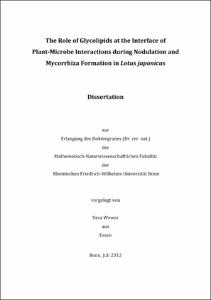The Role of Glycolipids at the Interface of PlantMicrobe Interactions during Nodulation and Mycorrhiza Formation in Lotus japonicus

The Role of Glycolipids at the Interface of PlantMicrobe Interactions during Nodulation and Mycorrhiza Formation in Lotus japonicus

| dc.contributor.advisor | Dörmann, Peter | |
| dc.contributor.author | Wewer, Vera | |
| dc.date.accessioned | 2020-04-18T18:20:23Z | |
| dc.date.available | 2020-04-18T18:20:23Z | |
| dc.date.issued | 09.04.2013 | |
| dc.identifier.uri | https://hdl.handle.net/20.500.11811/5648 | |
| dc.description.abstract | Lipids are important constituents of plant membranes, which represent the interface of plant-microbe interactions. In the present work, the role of membrane lipids of Lotus japonicus during root-nodule symbiosis with the nitrogen-fixing soil bacterium Mesorhizobium loti and during arbuscular mycorrhiza formation with the symbiotic fungus Glomus intraradices was analyzed. The main focus was the investigation of the glycolipids sterol glucoside (SG) and glucosylceramide (GlcCer). In contrast to the mass spectrometry based quantification of sphingolipids and phospho- and galactolipids, no method for the nondestructive measurement of plant sterol lipids has been described. Therefore, a novel method for the comprehensive quantification of free sterols (FSs), sterol glucosides (SGs), acylated sterol glucosides (ASGs) and sterol esters (SEs) in plants by quadrupole time-of-flight tandem mass spectrometry (Q-TOF MS/MS) was established and validated by comparison to quantification by thin layer chromatography/gas chromatography (TLC/GC). This method was applied to the quantification of sterol lipids in leaves and roots of Arabidopsis thaliana during phosphate deprivation. Furthermore, a comprehensive membrane lipid profile of Lotus japonicus during phosphate deprivation and during nodulation and mycorrhiza formation was obtained by Q-TOF MS/MS analysis. SG and GlcCer were shown to accumulate during nodulation, which suggested that these two lipids are important to establish plant-microbe interactions. Putative sterol glucosyltransferases genes (SGT1, SGT2) and glucosylceramide synthase (GCS) genes from Lotus were identified by sequence homologies to the respective genes from Arabidopsis. SGT RNAi lines with a downregulated gene expression of both SGT1 and SGT2 were generated, which showed a severe reduction of SG content in leaves, roots and nodules and a moderate reduction of ASG content in leaves and nodules, with a concomitant increase of SEs. RNAi lines with a downregulated gene expression of GCS showed a strong reduction of total GlcCer content in leaves, roots and nodules, together with changes in the molecular species composition. Nodulation and mycorrhiza formation were analyzed in the SGT and GCS RNAi lines to investigate, whether the reduced glycolipid content affected the efficiency to undergo plant-microbe interactions with Mesorhizobium loti and Glomus intraradices. | en |
| dc.language.iso | eng | |
| dc.rights | In Copyright | |
| dc.rights.uri | http://rightsstatements.org/vocab/InC/1.0/ | |
| dc.subject.ddc | 570 Biowissenschaften, Biologie | |
| dc.title | The Role of Glycolipids at the Interface of PlantMicrobe Interactions during Nodulation and Mycorrhiza Formation in Lotus japonicus | |
| dc.type | Dissertation oder Habilitation | |
| dc.publisher.name | Universitäts- und Landesbibliothek Bonn | |
| dc.publisher.location | Bonn | |
| dc.rights.accessRights | openAccess | |
| dc.identifier.urn | https://nbn-resolving.org/urn:nbn:de:hbz:5n-31565 | |
| ulbbn.pubtype | Erstveröffentlichung | |
| ulbbnediss.affiliation.name | Rheinische Friedrich-Wilhelms-Universität Bonn | |
| ulbbnediss.affiliation.location | Bonn | |
| ulbbnediss.thesis.level | Dissertation | |
| ulbbnediss.dissID | 3156 | |
| ulbbnediss.date.accepted | 29.11.2012 | |
| ulbbnediss.fakultaet | Mathematisch-Naturwissenschaftliche Fakultät | |
| dc.contributor.coReferee | Schreiber, Lukas |
Dateien zu dieser Ressource
Das Dokument erscheint in:
-
E-Dissertationen (4383)




